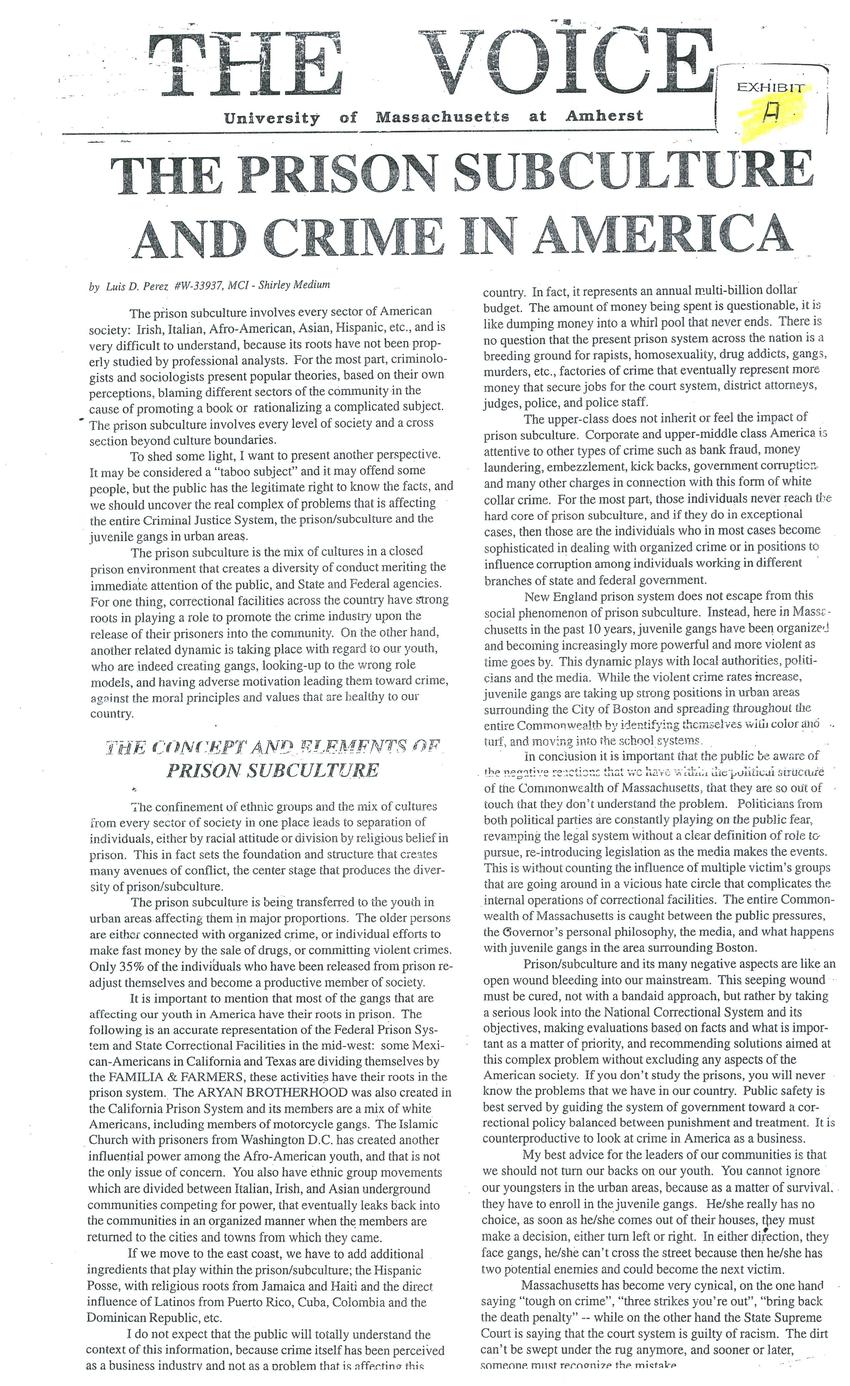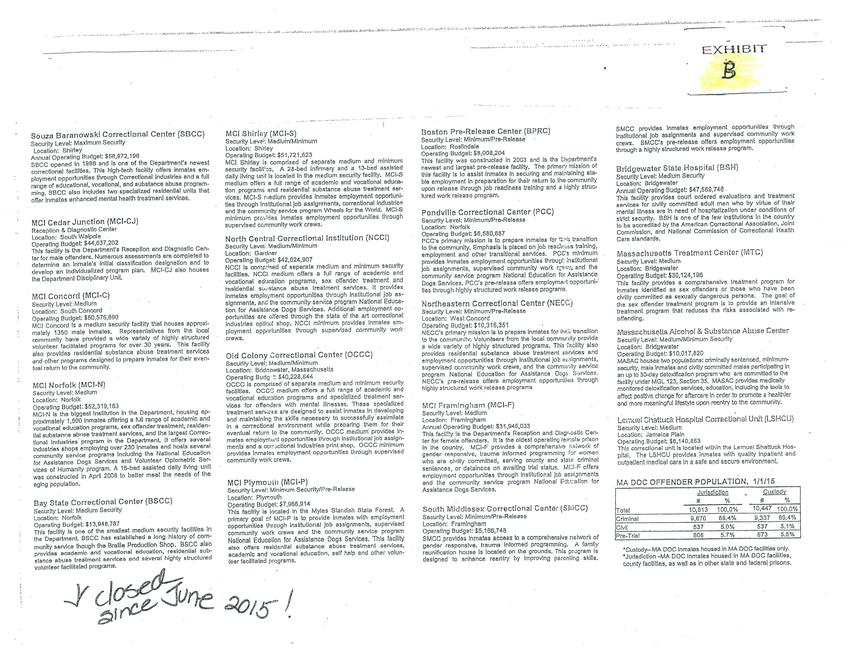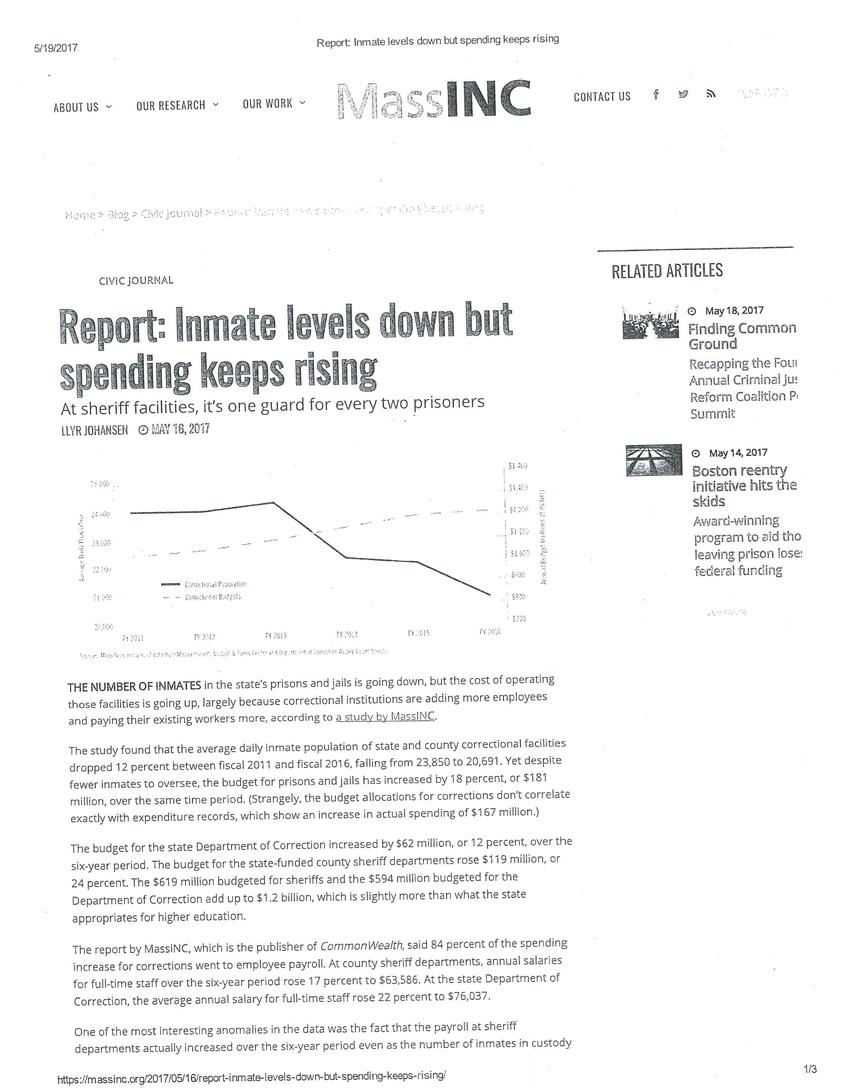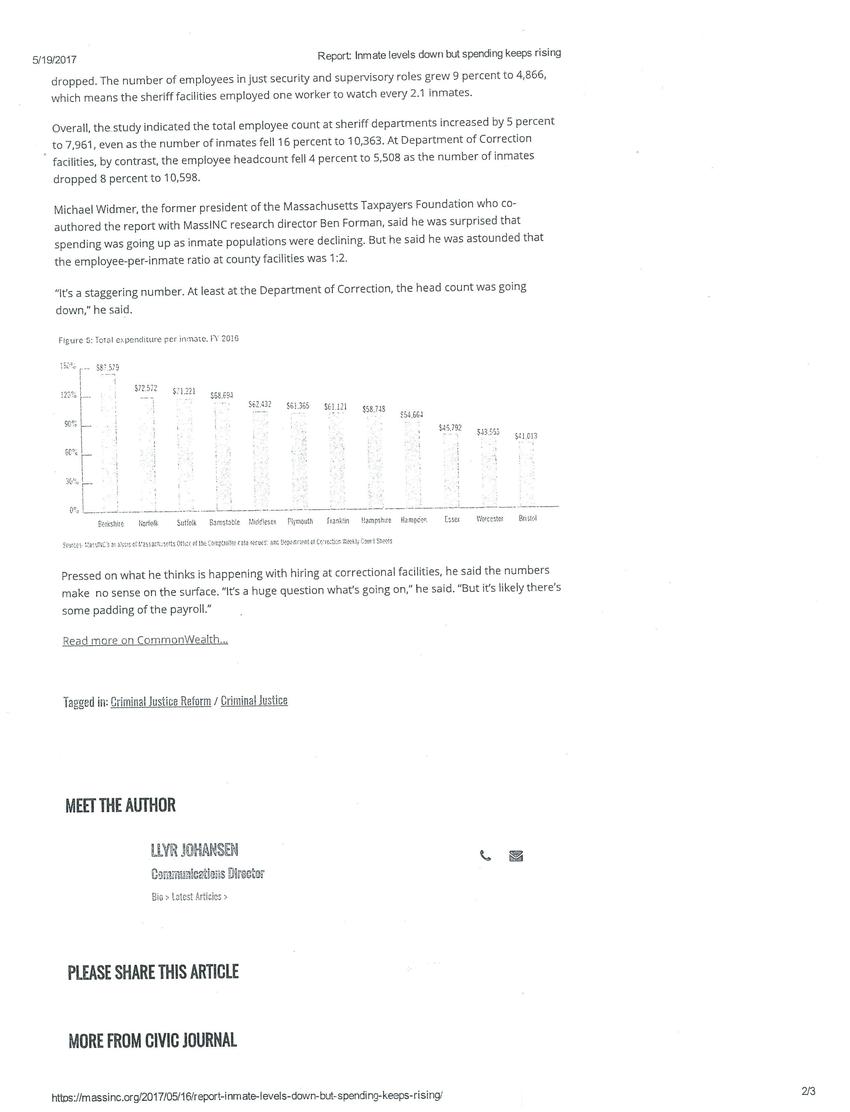
Transcription
OPEN LETTER TO GOVERNOR CHARLES D. BAKER
EXECUTIVE OFFICE
COMMONWEALTH OF MASSACHUSETTS
STATE HOUSE
BOSTON, MASSACHUSETTS 02133
IN RE: TRANSPARENCY ON YOUR SECOND TERM
MASSACHUSETTS DEPARTMENT OF CORRECTION
Dear Governor Baker;
GREETINGS!!
This is the last open-letter before the State Election which is a great opportunity to remind you that PRISON REFORM should be part of your agenda for the next term of your government.
“Please do not allow the systematic structure to block prison reform where money always trumps Civil Rights.”
As you must know, I am a prisoner in the custody of the Department of Correction serving a life sentence.. Even though that $2.1 million dollars is the sticken price of 47 years of incarceration, I am a poor person. I do not have money or a great lawyer, but in good faith my hope and expectation of change is resting on your shoulders.
Enclosed you will find a personal article/report that I wrote for the University of Amherst on “PRISON SUBCULTURE AND CRIME IN AMERICA” - Nov/December of 1994. as (Attachment/A)that represents a backdrop of today’s complex problems.
You will also find a copy of the State Budget divided between correctional facilities, which has been increased on fiscal year 2016-2017 while the prison population was reduced. Please see (Attachment-B).
It is also important that you be aware that on Re-Entry, Massachusetts has been graded as one of the best in the country, while on the other hand Massachusetts has one of the worst records on Medical/Compassionate release. See (Attachment-C).
Another interested point of view is the “Snapshot Pie Chart Over Time”. - The Expenditures for Executive Office of Public Safety and Homeland Security, Department of Correction (DOC). (See Attachment-D - for review and consideration).
Please note that the medical contract that is serving the inmates medical needs are separate from the budget assigned for the (DOC), which is over 280 million dollars if they are covering inmates in Houses of Correction in the Commonwealth. The research further indicated that the county jail expenditures are running on a separate budget of over $500 million dollars and that the sheriff Departments across the Commonwealth all have direct supervision by the Department of Correction.
GOVERNOR,
I am not saying this because you don’t know the facts, but with my limited resources I made a calculation that between both of those agencies and medical expenses the budget for fiscal year has already reached over $1.4 billion dollars.
CONCLUSION
I am hoping that you have read my open letters mailed to your office over the past six-months. I am a very expensive investment that secured jobs for other people. - My hope and dreams for prison reform is indeed resting on your shoulders. You have to break the vicious circle and create a justice system that is transparent and fair under the law.
Respectfully yours,
Luis D. Perez W33937
NCCI - GARDNER
500 Colony Road, P.O. Box 466
Gardner, Massachusetts 01440
OCTOBER 28th, 2018
EXHIBIT A
THE VOICE
University of Massachusetts at Amherst
THE PRISON SUBCULTURE AND CRIME IN AMERICA
by Luis D. Perez #W-33937, MCI - Shirley Medium
The prison subculture involves every sector of American society: Irish, Italian, Afro-American, Asian, Hispanic, etc., and is very difficult to understand, because it’s roots have not been properly studied by professional analysts. For the most part, criminologists and sociologists present popular theories, based on their own perceptions, blaming different sectors of the community in the cause of promoting a book or rationalizing a complicated subject. The prison subculture involves every level of society and a cross section beyond culture boundaries.
To shed some light, I want to present another perspective. It may be considered a “taboo subject” and it may offend some people; but the public has the legitimate right to know the facts, and we should uncover the real complex of problems that is affecting the entire Criminal Justice System, the prison/subculture and the juvenile gangs in urban area.
The prison subculture is the mix of cultures in a closed prison environment that creates a diversity of conduct meriting the immediate attention of the public, and State and Federal agencies. For one thing, correctional facilities across the country have strong roots in playing a role to promote the crime industry upon the release of their prisoners into the community. On the other hand, another related dynamic is taking place with regard to our youth, who are indeed creating gangs, looking-up to the wrong role models, and having adverse motivation leading them toward crime, against the moral principles and values that are healthy to our country.
THE CONCEPT AND ELEMENTS OF PRISON SUBCULTURE
The confinement of ethnic groups and the mix of cultures from every sector of society in one place leads to individuals, either by racial attitude or division by religious belief in prison. This in fact sets the foundation and structure that creates many avenues of conflict, the center stage that produces the diversity of prison/subcculture.
The prison subculture is being transferred to the youth in urban areas affecting them in major proportions. The older persons are either connected with organized crime, or individual efforts to make fast money but the sale of drugs, or committing violent crimes. Only 35% of the individuals who have been released from prison readjust themselves and become a productive member of society.
It is important to mention that most of the gangs that are affecting our youth in America have their roots in prison. The following is an accurate representation of the Federal Prison System and State Correctional Facilities in the mid-west; some Mexican-Americans in California and Texas are dividing themselves by the FAMILIA & FARMERS, these activities have their roots in the prison system. The ARYAN BROTHERHOOD was also created in the California Prison System and its members are a mix of white Americans, including members of motorcycle gangs. The Islamic Church with prisoners from Washington D.C. has created another influential power among the Afro-American youth, and that is not the only issue of concern. You also have ethnic group movements which are divided between Italian, Irish, and Asian underground communities competing for power, that eventually leaks back into the communities in an organized manner when the members are returned to the cities and towns from which they came.
If we move to the east coast, we have to add additional ingredients that play within the prison/subculture; the Hispanic Posse, with religious roots from Jamaica and Haiti and the direct influence of Latinos from Puerto Rico, Cuba, Colombia and the Dominican Republic, etc.
I do not expect that the public will totally understand the context of this information, because crime itself has been perceived as a business industry and not as a problem that is affecting this country. In fact, it represents an annual multi-billion dollar budget. The amount of money being spent is questionable, it si like dumping money into a whirl pool that never ends. There is no question that the present prison system across the nations a breeding ground for rapists, homosexuality, drug addicts, gangs, murders, etc., factories of crime that eventually represent more money that secure jobs for the court system, district attorneys, judges, police, and police staff.
The upper-class does not inherit or feel the impact of prison subculture. Corporate and upper-middle class America is attentive to other types of crime such as bank fraud, money laundering, embezzlement, kickbacks. government corruption and many other charges in connection with this form of white collar crime. For the most part, those individuals never reach the hard core of prison subculture, and if they do in exceptional cases, then those are the individuals who in most cases become sophisticated in dealing with organized crime or in positions to influence corruption among individuals working in different branches of state and federal government.
New England prison system does not escape from this social phenomenon of prison subculture. Instead, here in Massachusetts in the past 10 years, juvenile gangs have been organized and becoming increasingly more powerful and more violent as time goes by. This dynamic plays with local authorities, politicians and the media. While the violent crime rates increase, juvenile gangs are taking up strong positions in urban areas surrounding the City of Boston and spreading throughout the entire Commonwealth by identifying themselves with color and turf, and moving into the school systems.
In conclusion it is important that the public be aware of the negative reactions that we have within the political structure of the Commonwealth of Massachusetts, that they are so out of touch that they don't understand the problem. Politicians from both political parties are constantly playing on the public fear, revamping the legal system without a clear definition of role to pursue, re-introducing legislation as the media makes the events. This is without counting the influence of multiple victim's groups that are going around in a vicious hate circle that complicates the internal operations of correctional facilities. The entire Commonwealth of Massachusetts is caught between the public pressures, the Governor's personal philosophy, the media, and what happens with juvenile gangs in the area surrounding Boston.
Prison/subculture and its many negative aspects are like an open wound bleeding into our mainstream. This seeping wound must be cured, not with a bandaid approach, but rather by taking a serious look into the National Correctional System and its objectives, making evaluations based on facts and what is important as a matter of priority, and recommending solutions aimed at this complex problem without excluding any aspects of the American society. If you don't study the prisons, you will never know the problems that we have in our country. Public safety is best served by guiding the system of government toward a correctional policy balanced between punishment and treatment. It is counterproductive to look at crime in America as a business.
My best advice for the leaders of our communities is that we should not turn our backs on our youth. You cannot ignore our youngsters in the urban areas, because as matter of survival they have to enroll in the juvenile gangs. He/she really has no choice, as soon as he/she comes out of their houses, they must make a decision, either turn left or right. In either direction they face gangs, he/she can't cross the street because then he/she has two potential enemies and could become the next victim.
Massachusetts has become very cynical, on the one hand saying "tough on rime", "three strikes you're out", "bring back the death penalty" -- while on the other hand the State Supreme Court is saying that the court system is guilty of racism. The dirt can't be swept under the rug anymore, and sooner or later, someone must recognize the mistake.
Exhibit B
Souza Baranowski Correctional Center (SBCC)
Security Level: Maximum Security
Location: Shirley
Annual Operating Budget: $58,972,196
SBCC opened in 1998 and is one of the Department’s newest
correctional facilities. This high-tech facility offers inmates employment opportunities through Correctional Industries and a full
range of educational, vocational, and substance abuse programming. SBCC also includes two specialized residential units that
offer inmates enhanced mental health treatment services.
MCI Cedar Junction (MCI-CJ)
Reception & Diagnostic Center
Location: South Walpole
Operating Budget: $44,637,202
This facility is the Department’s Reception and Diagnostic Center for male offenders. Numerous assessments are completed to
determine an inmate’s initial classification designation and to
develop an individualized program plan. MCI-CJ also houses
the Department Disciplinary Unit.
MCI Concord (MCI-C)
Security Level: Medium
Location: South Concord
Operating Budget: $50,576,890
MCI Concord is a medium security facility that houses approximately 1350 male inmates. Representatives from the local
community have provided a wide variety of highly structured
volunteer facilitated programs for over 30 years. This facility
also provides residential substance abuse treatment services
and other programs designed to prepare inmates for their eventual return to the community.
MCI Norfolk (MCI-N)
Security Level: Medium
Location: Norfolk
Operating Budget: $52,319,183
MCI-N is the biggest institution in the Department, housing approximately 1,500 inmates offering a full range of academic and
vocational education programs, sex offender treatment, residential substance abuse treatment services, and the largest Correctional Industries program in the Department. It offers several
industries shops employing over 230 inmates and hosts several
community service programs including the National Education
for Assistance Dogs Services and Volunteer Optometric Services of Humanity program. A 16-bed assisted daily living unit
was constructed in April 2008 to better meet the needs of the
aging population.
Bay State Correctional Center (BSCC)
Security Level: Medium Security
Location: Norfolk
Operating Budget: $13,948,787
This facility is one of the smallest medium security facilities in
the Department. BSCC has established a long history of community service though the Braille Production Shop. BSCC also
provides academic and vocational education, residential substance abuse treatment services and several highly structured
volunteer facilitated programs. (closed since June 2015)
MCI Shirley (MCI-S)
Security Level: Medium/Minimum
Location: Shirley
Operating Budget: $51,721,623
MCI Shirley is comprised of separate medium and minimum
security facilities. A 28-bed infirmary and a 13-bed assisted
daily living unit is located in the medium security facility. MCI-S
medium offers a full range of academic and vocational education programs and residential substance abuse treatment services. MCI-S medium provides inmates employment opportunities through institutional job assignments, correctional industries
and the community service program Wheels for the World. MCI-S
minimum provides inmates employment opportunities through
supervised community work crews.
North Central Correctional Institution (NCCI)
Security Level: Medium/Minimum
Location: Gardner
Operating Budget: $42,024,907
NCCI is comprised of separate medium and minimum security
facilities. NCCI medium offers a full range of academic and
vocational education programs, sex offender treatment and
residential substance abuse treatment services. It provides
inmates employment opportunities through institutional job assignments, and the community service program National Education for Assistance Dogs Services. Additional employment opportunities are offered through the state of the art correctional
industries optical shop. NCCI minimum provides inmates employment opportunities through supervised community work
crews.
Old Colony Correctional Center (OCCC)
Security Level: Medium/Minimum
Location: Bridgewater, Massachusetts
Operating Budget: $40,228,844
OCCC is comprised of separate medium and minimum security
facilities. OCCC medium offers a full range of academic and
vocational education programs and specialized treatment services for offenders with mental illnesses. These specialized
treatment services are designed to assist inmates in developing
and maintaining the skills necessary to successfully assimilate
in a correctional environment while preparing them for their
eventual return to the community. OCCC medium provides inmates employment opportunities through institutional job assignments and a correctional industries print shop. OCCC minimum
provides inmates employment opportunities through supervised
community work crews.
MCI Plymouth (MCI-P)
Security Level: Minimum Security/Pre-Release
Location: Plymouth
Operating Budget: $7,966,914
This facility is located in the Myles Standish State Forest. A
primary goal of MCI-P is to provide inmates with employment
opportunities through institutional job assignments, supervised
community work crews and the community service program
National Education for Assistance Dogs Services. This facility
also offers residential substance abuse treatment services,
academic and vocational education, self help and other volunteer facilitated programs.
Boston Pre-Release Center (BPRC)
Security Level: Minimum/Pre-Release
Location: Roslindale
Operating Budget: $8,008,204
This facility was constructed in 2003 and is the Department’s
newest and largest pre-release facility. The primary mission of
this facility is to assist inmates in securing and maintaining stable employment in preparation for their return to the community
upon release through job readiness training and a highly structured work release program.
Pondville Correctional Center (PCC)
Security Level: Minimum/Pre-Release
Location: Norfolk
Operating Budget: $6,580,687
PCC’s primary mission is to prepare inmates for their transition
to the community. Emphasis is placed on job readiness training,
employment and other transitional services. PCC’s minimum
provides inmates employment opportunities through institutional
job assignments, supervised community work crews and the
community service program National Education for Assistance
Dogs Services. PCC’s pre-release offers employment opportunities through highly structured work release programs.
Northeastern Correctional Center (NECC)
Security Level: Minimum/Pre-Release
Location: West Concord
Operating Budget: $10,316,351
NECC’s primary mission is to prepare inmates for their transition
to the community. Volunteers from the local community provide
a wide variety of highly structured programs. This facility also
provides residential substance abuse treatment services and
employment opportunities through institutional job assignments,
supervised community work crews, and the community service
program National Education for Assistance Dogs Services.
NECC’s pre-release offers employment opportunities through
highly structured work release programs
MCI Framingham (MCI-F)
Security Level: Medium
Location: Framingham
Annual Operating Budget: $31,945,033
This facility is the Department's Reception and Diagnostic Center for female offenders. It is the oldest operating female prison
in the country. MCI-F provides a comprehensive network of
gender responsive, trauma informed programming for women
who are civilly committed, serving county and state criminal
sentences, or detainees on awaiting trial status. MCI-F offers
employment opportunities through institutional job assignments
and the community service program National Education for
Assistance Dogs Services.
South Middlesex Correctional Center (SMCC)
Security Level: Minimum/Pre-Release
Location: Framingham
Operating Budget: $5,166,748
SMCC provides inmates access to a comprehensive network of
gender responsive, trauma informed programming. A family
reunification house is located on the grounds. This program is
designed to enhance reentry by improving parenting skills.
SMCC provides inmates employment opportunities through
institutional job assignments and supervised community work
crews. SMCC’s pre-release offers employment opportunities
through a highly structured work release program.
Bridgewater State Hospital (BSH)
Security Level: Medium Security
Location: Bridgewater
Annual Operating Budget: $47,569,746
This facility provides court ordered evaluations and treatment
services for civilly committed adult men who by virtue of their
mental illness are in need of hospitalization under conditions of
strict security. BSH is one of the few institutions in the country
to be accredited by the American Correctional Association, Joint
Commission, and National Commission of Correctional Health
Care standards.
Massachusetts Treatment Center (MTC)
Security Level: Medium
Location: Bridgewater
Operating Budget: $30,124,196
This facility provides a comprehensive treatment program for
inmates identified as sex offenders or those who have been
civilly committed as sexually dangerous persons. The goal of
the sex offender treatment program is to provide an intensive
treatment program that reduces the risks associated with reoffending.
Massachusetts Alcohol & Substance Abuse Center
Security Level: Medium/Minimum Security
Location: Bridgewater
Operating Budget: $10,017,820
MASAC houses two populations: criminally sentenced, minimumsecurity, male inmates and civilly committed males participating in
an up to 30-day detoxification program who are committed to the
facility under MGL 123, Section 35. MASAC provides medically
monitored detoxification services, education, including the tools to
affect positive change for aftercare in order to promote a healthier
and more meaningful lifestyle upon reentry to the community.
Lemuel Shattuck Hospital Correctional Unit (LSHCU)
Security Level: Medium
Location: Jamaica Plain
Operating Budget: $6,140,853
This correctional unit is located within the Lemuel Shattuck Hospital. The LSHCU provides inmates with quality inpatient and
outpatient medical care in a safe and secure environment.
MA DOC OFFENDER POPULATION, 1/1/15
Jurisdiction Custody
# % # %
Total 10,813 100.0% 10,447 100.0%
Criminal 9,670 89.4% 9,337 89.4%
Civil 537 5.0% 537 5.1%
Pre-Trial 606 5.7% 573 5.5%
*Custody– MA DOC inmates housed in MA DOC facilities only.
*Jurisdiction -MA DOC inmates housed in MA DOC facilities,
county facilities, as well as in other state and federal prisons.
5/19/2017 Report: Inmate levels down but spending keeps rising
About us Our Research Our Work MassINC Contact us
Home>Blog>Civic Journal>Report: Inmate levels down but spending keeps rising
Report: Inmate levels down but spending keeps rising
At sheriff facilities, it’s one guard for every two prisoners
May 16, 2017
[line graph of annual budget to annual population]
THE NUMBER OF INMATES in the state’s prisons and jails is going down, but the cost of operating those facilities is going up, largely because correctional institutions are adding more employees and paying their existing workers more, according to a study by MassINC.
The study found that the average daily inmate population of state and county correctional facilities dropped 12 percent between fiscal 2011 and fiscal 2016, falling from 23,850 to 20,691. Yet despite fewer inmates to oversee, the budget for prisons and jails has increased by 18 percent, or $181 million, over the same time period. (Strangely, the budget allocations for corrections don’t correlate exactly with expenditure records, which show an increase in actual spending of $167 million.)
The budget for the state Department of Correction increased by $62 million, or 12 percent, over the six-year period. The budget for the state-funded county sheriff departments rose $119 million, or 24 percent. The $619 million budgeted for sheriffs and the $594 million budgeted for the Department of Correction add up to $1.2 billion, which is slightly more than what the state appropriates for higher education.
The report by MassINC, which is the publisher of CommonWealth, said 84 percent of the spending increase for corrections went to employee payroll. At county sheriff departments, annual salaries for full-time staff over the six-year period rose 17 percent to $63,586. At the state Department of Correction, the average annual salary for full-time staff rose 22 percent to $76,037.
One of the most interesting anomalies in the data was the fact that the payroll at sheriff departments actually increased over the six-year period even as the number of inmates in custody dropped. The number of employees in just security and supervisory roles grew 9 percent to 4,866, which means the sheriff facilities employed one worker to watch every 2.1 inmates.
Overall, the study indicated the total employee count at sheriff departments increased by 5 percent to 7,961, even as the number of inmates fell 16 percent to 10,363. At Department of Correction facilities, by contrast, the employee headcount fell 4 percent to 5,508 as the number of inmates dropped 8 percent to 10,598.
Michael Widmer, the former president of the Massachusetts Taxpayers Foundation who co-authored the report with MassINC research director Ben Forman, said he was surprised that spending was going up as inmate populations were declining. But he said he was astounded that the employee-per-inmate ratio at county facilities was 1:2.
“It’s a staggering number. At least at the Department of Correction, the head count was going down,” he said.
[bar graph of total expenditure per inmate]
Pressed on what he thinks is happening with hiring at correctional facilities, he said the numbers make no sense on the surface. “It’s a huge question what’s going on,” he said. “But it’s likely there’s some padding of the payroll.”
Read more on CommonWealth...
Tagged in: criminal Justice Reform/Criminal Justice
MEET THE AUTHOR
LLYR JOHANSEN
Communications Director
Bio>Latest Articles>
PLEASE SHARE THIS ARTICLE
MORE FROM CIVIC JOURNAL
https://massinc.org/2017/05/16/report-inmate-levels-down-but-spending-keeps-rising/
Other posts by this author
|
2023 feb 2

|
2022 dec 26

|
2022 nov 5

|
2022 aug 23

|
2022 jun 23

|
2022 may 4

|
More... |







Replies